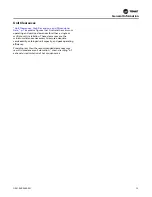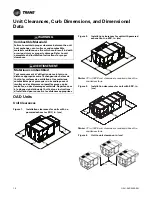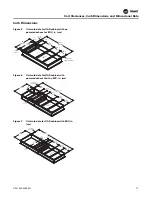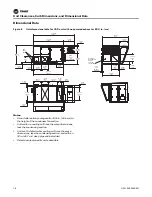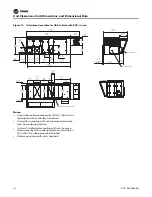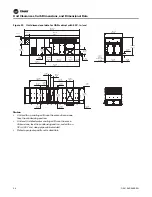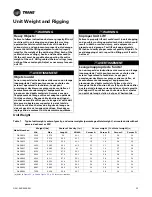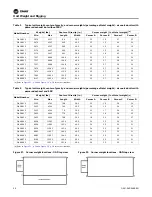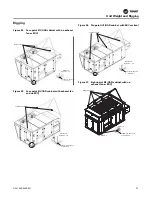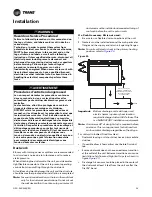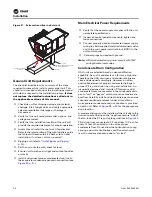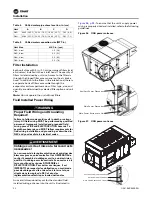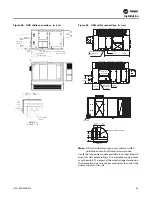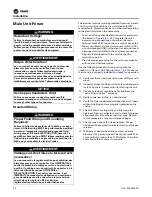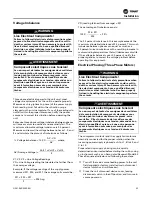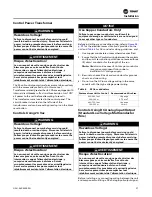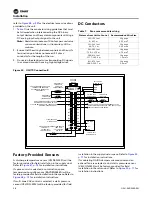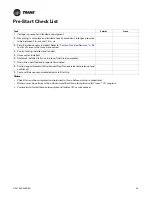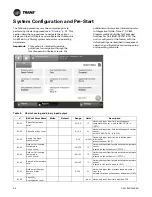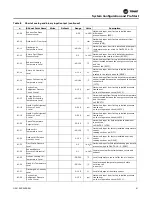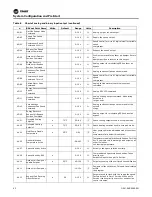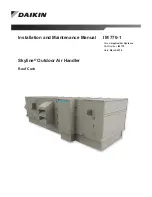
OAU-SVX006E-EN
29
Installation
Ductwork
Elbows with turning vanes or splitters are recommended
to minimize air noise due to turbulence and to reduce
static pressure.
When attaching the ductwork to the unit, provide a water-
tight flexible connector at the unit to prevent operating
sounds from transmitting through the ductwork.
All outdoor ductwork between the unit and the structure
should be weather proofed after installation is completed.
Note:
For sound consideration, cut holes in the roof deck
only for the ductwork penetrations. Do not cut out
the roof deck within the entire curb perimeter. All
duct work must be installed and connected to top of
roof curb before the unit is set on curb.
If a Curb Accessory Kit is not used:
1. Be sure to use flexible duct connections at the unit.
2. Gaskets must be installed around the curb perimeter
flange and the supply and return air opening flanges.
Note:
For units will electric heat in the primary heating
position, refer to
.
Note:
A minimum 48" of straight duct is required before
an elbow. This is a requirement for both vertical
and horizontal discharge regardless of heat type.
For units with Indirect Fired Gas Heat:
•
Ductwork leaving unit should not have an immediate
duct tee.
•
If possible allow 4 feet vertical duct before first duct
tee.
•
Ensure duct work does not have an extreme transition
at the outlet of the unit. Extreme transitions can cause
restriction of airflow and high limit trips (as shown in
figure
•
Discharge Air sensor should be placed in the center of
the ductwork at least 4 feet from the unit or after the
first 90° bend.
WARNING
Hazardous Service Procedures!
Failure to follow all precautions in this manual and on
the tags, stickers, and labels could result in death or
serious injury.
Technicians, in order to protect themselves from
potential electrical, mechanical, and chemical hazards,
MUST follow precautions in this manual and on the
tags, stickers, and labels, as well as the following
instructions: Unless specified otherwise, disconnect all
electrical power including remote disconnect and
discharge all energy storing devices such as capacitors
before servicing. Follow proper lockout/tagout
procedures to ensure the power can not be
inadvertently energized. When necessary to work with
live electrical components, have a qualified licensed
electrician or other individual who has been trained in
handling live electrical components perform these
tasks.
AVERTISSEMENT
Procédures d’entretien dangereuses!
Le non-respect de toutes les précautions contenues
dans ce manuel ainsi que sur les étiquettes et les
autocollants peut entraîner des blessures graves voire
mortelles.
Les techniciens, afin d’être protégés des éventuels
risques électriques, mécaniques et chimiques,
DOIVENT suivre les précautions contenues dans ce
manuel, sur les étiquettes et les autocollants, ainsi que
les instructions suivantes : Sauf indication contraire,
coupez toute l’alimentation électrique y compris les
disjoncteurs à distance et déchargez tous les dispositifs
de stockage d’énergie comme les condensateurs avant
l’entretien. Respectez les procédures de verrouillage et
d’étiquetage appropriées pour éviter tout risque de
remise sous tension accidentelle. S’il est nécessaire de
travailler avec des composants électriques sous
tension, demandez à un électricien qualifié et agréé ou
à une autre personne ayant la formation nécessaire
pour manipuler des composants électriques sous
tension d’exécuter ces tâches.
Figure 30.
Important:
Bottom discharge units with open coil
electric heater in primary heat location
require discharge duct with 90° elbow. This
is a MANDATORY installation requirement.
48 in. (121.9 cm)
minimum straight duct
distance before an elbow
for either gas heat
or electric heat
Airflow

